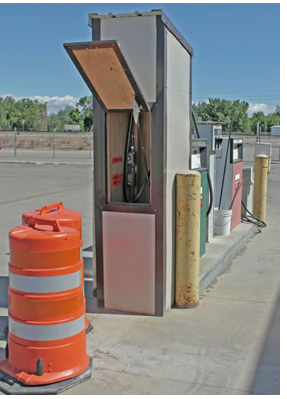
District 4's Bolton creates custom solution to common diesel-delivery issues
Thousands of ITD truck operators statewide must use a DEF (Diesel Exhaust Fluid) delivery system in order to operate new Mack trucks recently added to the equipment fleet for maintenance. Several issues have cropped up, though, making the process more cumbersome. Without the DEF additive, the trucks become disabled, so addressing the problems quickly was paramount. With that backdrop, District 4 Mechanic Jon Bolton created customized solutions to these hurdles.
Several problems existed:
- If the operator forgets to fill the DEF tank and the truck runs out of DEF, it becomes disabled. This is a safety hazard, is a reduction of services provided to customers, and is a financial burden to the district budget — the cost of transporting the disabled truck to the dealer, combined with the out-of-pocket cost of the dealer reprogramming the truck computer, is about $2,000 per truck.
- DEF is susceptible to freezing, so the storage and distribution location needs to protect it from extreme cold. The fluid freezes at 15 degrees Fahrenheit.
- The storage area also needed to be big enough for the 250-gallon DEF tote and not be an obstruction hazard for snowplows fueling at the station
.- The electric pump for pumping the DEF has only dead-head time (pump running "dry" with no fluid to pump) of three minutes before the pump is destroyed.
Pictured to right is Bolton, along with a closer look inside the control cabinet at the electrical-engineering work that this project required.
Bolton had a few ideas, which ultimately became the innovation to solve the problem for District 4 operators. First, he positioned the DEF nozzle next to the diesel nozzle so a driver could refill his/her DEF tank and diesel fuel tank simultaneously, with the hope that having the nozzles in close proximity would help the operators to remember to fill the DEF tank as well.
However, Bolton found that the fuel island was too narrow for a heated building to be built that could hold the large DEF tote. District 4's carpenter crew was recruited to complete the required construction. The carpenter crew constructed a narrow building the same width of the fueling island and saw-cut the concrete for a trench into the service station building.
Inside the service station, at the end of the PVC pipe, D4 placed a small electrical fan to push the warmer air from inside the station to the fueling station. Warm air circulates through the trench, preventing the six-inch PVC conduit from freezing during the winter.
Pictured to left is the DEF filling station with DEF pump switch. Notice the width of the filling station fits within the island's protective barriers. The DEF station has an off/on switch for the pump and is equipped with a lift assist on the door.
To solve the dead-head issue with the pump, Bolton designed and built a timer/control system for the DEF pumping system to negate the possibility of drivers being unable to hear the pump running and forgetting to turn it off before the $400 pump was destroyed.
"The system also has a pump running light on the start box, a night light at the DEF station, push-start button and a Class I electrical system," explained Bolton. "And for the safety and convenience of the drivers, the DEF station has a night light, a cam over lift ram to hold the door open, and a counter weighted hose-retractor system."
Also, while this work was being completed, D4 updated the fuel emergency shut-off system.
Bolton gave special thanks to D4's Supply, Carpenter and Electrical crews for their assistance with this project.
Published 07-01-16